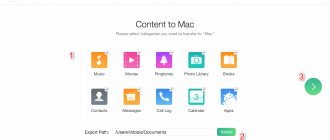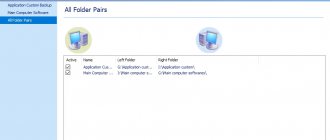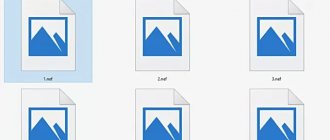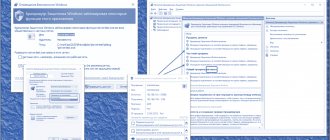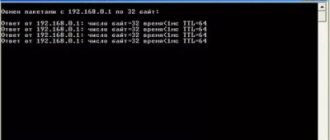Example
Let's look at an example right away. There is such a video hosting site - Vimeo. And they have their own Android application on the market.
If you google, for example, “vimeo video”, then Google will show several videos in the results, clicking on which you can go to the Vimeo site. Those. the browser will open a link like https://vimeo.com/236370796. But if you do this on an Android smartphone on which the Vimeo application is installed, then it will open instead of the site. The system sees that there is an application that can open such a link and launches it.
If the Vimeo application is not installed, its Instant App version may open.
This is an application that we did not even explicitly install. The system itself downloaded and installed it, and opened the video in it. (I don't know why the recorder didn't record the video that plays at the top of the screen, but it's there). Please also note that this application has a button to proceed to installing the full version from the market.
If Instant App does not start for you, then make sure that it is enabled in the system settings: Settings -> Google -> Instant App. If you don't have the Instant App item in your settings, then your device doesn't support it.
Those. the system intercepted the link, determined that there was an Instant App application for it, downloaded it and launched it. Link plays a very important role in this technology. Essentially, the URL is the entry point to the application. A little later I will tell you how this binding is implemented.
And this is what a full-fledged version of the Vimeo application looks like, installed from the market.
It can be seen that the screens of both versions are very similar, but the Instant App version has limited functionality. Instant App is a light version of the main application. As we have already seen, it can be quickly loaded and displayed when you click on a link.
Connection
How to install and connect this service?
It was first introduced into the version of the Android 6.0 operating system - it came in an update package specifically for it.
Therefore, at present it is possible to run it only on devices with an operating system version of at least 6.0.
Also, this service is initially present on new phones with this version of Android. For this reason, now, regardless of the user’s wishes, this service is connected and successfully operates on almost all devices with the 6.0 operating system.
However, it is missing on older versions and cannot be downloaded from official sources.
If you really need this service, then there is only one way to get it - by flashing your device and changing the OS version, since it is built into it.
However, this feature may simply be disabled on the smartphone. Turning it on is quite simple.
To do this, do the following:
1Go to the Settings section on your device;
2Go to the Google section ;
3 Find the item – Instant Launch Applications;
4 Drag the slider to the on position.
<Fig. 7 Connect>
This same section of the menu will then display a list of all the instant apps that you viewed using this feature.
The main problem is that the program is activated, updated, launched, etc. without the user’s knowledge. It is impossible to solve this problem, since such behavior is considered normal for Google programs. You can simply turn off the program using the method described above - by dragging the slider to the off position.
If you have Telegram, you can now download any software or game through our bot, just follow the link and try it!
« Previous entry
Why do you need Instant App?
Why might this be needed? The most obvious answer is to get more installs of your app. The user finds something on Google (or simply receives a link in messenger, mail, etc.), clicks on the link and your Instant App application opens. It allows the user to see approximate functionality and encourages them to install the full version. This way you will get a new user. Those. Instant App is a classic demo version of the application that helps the user decide whether to install the full version.
What is Install.app? How to fix errors associated with it? [SOLVED]
Sometimes install.app and other APP system errors can be related to problems in the Windows registry. Several programs can use the install.app file, but when those programs are uninstalled or modified, sometimes "orphaned" (incorrect) APP registry entries are left behind.Basically, this means that while the actual path of the file may have changed, its incorrect former location is still recorded in the Windows Registry. When Windows tries to look up these incorrect file references (file locations on your PC), install.app errors can occur. Additionally, malware infection may have corrupted the registry entries associated with HP Color LaseJet 2820/2840 CD 1. Therefore, these corrupted APP registry entries need to be fixed to fix the problem at the root.
Manually editing the Windows registry to remove invalid install.app keys is not recommended unless you are PC service professional. Mistakes made when editing the registry can render your PC inoperable and cause irreparable damage to your operating system. In fact, even one comma placed in the wrong place can prevent your computer from booting!
Due to this risk, to simplify the process, it is recommended to use a program to clean the OS registry. Registry cleaner automates the process of finding invalid registry entries, missing file references (like the one causing the install.app error), and broken links in the registry. Before each scan, a backup is automatically created with the ability to undo any changes with one click, protecting against the possibility of damaging your PC.
As a Microsoft Silver Partner, we provide software to help you resolve the following issues:
- WinThruster OS registry cleaner [download]
Warning: Unless you are an experienced PC user, we DO NOT recommend manually editing the Windows Registry. Using Registry Editor incorrectly may cause serious problems that may require you to reinstall Windows. We do not guarantee that problems resulting from incorrect use of Registry Editor can be corrected. You use Registry Editor at your own risk.
Before you manually repair the Windows registry, you must create a backup by exporting the portion of the registry associated with install.app (for example, HP Color LaseJet 2820/2840 CD 1):
- Click on the Start .
- Type " command " in the search bar... DON'T PRESS ENTER YET !
- CTRL-Shift keys on your keyboard, press ENTER .
- A dialog box for access will be displayed.
- Click Yes .
- The black box opens with a blinking cursor.
- Type " regedit " and press ENTER .
- In the Registry Editor, select the install.app-related key (for example, HP Color LaseJet 2820/2840 CD 1) you want to back up.
- From the File , select Export .
- From the Save in , select the folder where you want to save the backup copy of the HP Color LaseJet 2820/2840 CD 1 key.
- In the File Name , enter a name for the backup file, for example, “HP Color LaseJet 2820/2840 CD 1 Backup.”
- Make sure that the Export Range is set Selected Branch .
- Click Save .
- The file will be saved with the extension .reg .
- You now have a backup of your install.app-related registry entry.
The following steps for manually editing the registry will not be described in this article, as they are likely to damage your system. If you would like more information about editing the registry manually, please check out the links below.
We do not accept any responsibility for the results of the actions performed according to the instructions below - you perform these tasks at your own risk.
Windows XP https://www.theeldergeek.com/windows_xp_registry.htm
Windows 7 https://www.theeldergeek.com/windows_7/registry_edits_for_win7.htm
Windows Vista https://support.microsoft.com/kb/2688326 - LetMeFixItMyselfAlways
How to create an Instant App application
Let's figure out where this Instant App version came from and how to create it.
It was created in the same project as the main application. But in order to be able to create a lightweight and limited version, it is necessary to divide the main application code into modules.
What modules are we talking about? About the same ones we work with in Android Studio. By default, we only create the app module. If we work according to Clean Architecture, we usually create several more modules. And if we are going to create an Instant App application, then we put individual features of the application into modules.
In the example with Vimeo, such a feature is the video viewing screen. Those. The application has some kind of Activity that is responsible for this screen. It is placed in a separate module. Let's call this module videoplay. In this module, in addition to Actiivty, we include the classes it uses - adapters, presenters, custom views, etc. That is. there should be classes that only this Activity needs to work and no one else.
For commonly used repositories and other classes that will be used in modules, there is a separate module called base.
Each feature module has a dependency on the base module:
dependencies { implementation project(':base') … }
However, this does not prevent the base module from being a feature module. It can also contain an Activity.
As a result, your project consists of one base module and several feature modules. From all this we can assemble two types of application.
The first is a regular full-fledged APK that will include all your feature modules.
The second is a limited Instant App application that will include a base module and those feature modules that you want to see in this application.
To provide us with the opportunity to build two different applications from one code, the Instant App project has two build modules: installed and instant.
installed will build a full-fledged application for us, and instant will build the Instant App version.
These modules contain gradle files in which we write feature modules that will be used when building the application.
dependencies { implementation project(':base') implementation project(':feature1') implementation project(':feature2') }
Accordingly, in the gradle file of the installed module, we usually indicate all feature modules in order to obtain an APK with full functionality. And in the instant gradle file we specify only those feature modules that we want to see in the Instant App application.
The installed module will build an APK that will use the modules as libraries. And the instant module will make a separate APK from each module and pack all these APKs into one ZIP.
What is this program and the reasons for problems with it
The Google Play service develops every year and acquires new capabilities and technologies. The Services for Instant app allows you to preview games and programs. This way you can determine whether the found application is needed on your smartphone. This is a useful feature that will allow you to save disk space. The function is available in smartphones with Android version 6 and higher. It cannot be deleted without special superuser (or Root) rights. But even if deleted, it can be restored.
Preview was relatively recently introduced to Google Play. And this option is not available for all applications. If you see such a failure in your device, then it may be caused by the fault of the developers. They may have configured it incorrectly and now the Instant Launch feature is unavailable or displaying error text.
Another similar error often occurs in Android: the com.android.phone process has stopped - what to do?
URL
I already mentioned that the URL is the entry point to the Activity.
Each feature module must contain at least one Activity (more is possible). And for this, the Activity must be configured with an IntentFilter to a specific URL.
When a user clicks on a link, the following happens.
The system finds that there is an Instant App application in the market, which has a feature module that can open such links.
Just above I wrote that the Instant App application is a ZIP, which contains all the feature modules and the base module in the form of separate APKs. In the case of Vimeo, for example, these could be, for example, the files videoplay.apk (created from the videoplay feature module) and base.apk (created from the base module). And in videoplay.apk there is an Activity for which the IntentFilter is configured on the vimeo.com link.
The system downloads videoplay.apk to the device and launches it. Along with it, it also downloads base.apk. Those. When a feature APK file is first downloaded from the Instant App, the base.apk is always downloaded along with it. Because all features are dependent on base. This, by the way, leads to one limitation. The total size of any feature APK file and base.apk should not exceed 4 megabytes. Those. in our case, the total size of the videoplay.apk and base.apk files should not exceed 4 MB. This is done to make Instant Apps as lightweight and fast to load as possible.
It is important to understand here that, even if the Instant App application contains any other feature APK files, the system will only download videoplay.apk (+ base.apk). Because at the moment, only this file is needed to process the clicked link.
What if the screen from videoplay.apk provides the opportunity to go to some other screen, for example, the comments screen? In this case, the transition should be implemented programmatically not using the Intent that calls the Activity, but using the Intent that calls the link. For example, it could be a link like https://vimeo.com/236370796/comments.
Let's assume that the project has a videocomments feature module, which contains an Activity with an IntentFilter configured for such links. And this feature module was included in the list in the instant module. In this case, the system will find that the Instant App application also has a videocomments.apk file, which contains an Activity configured for this type of link. The system will download and launch videocomments.apk. The base.apk file in this case will no longer be loaded, because it was downloaded earlier.
Additional ways to fix the problem on Google Play
All versions of the mobile OS are subject to bugs and crashes in the Services for Instant Apps application. This is due to the fact that it is still under development. Therefore, other methods of troubleshooting can help you in dealing with these failures. Next, follow these instructions:
- Go into Android settings again. Here you need to find “Accounts”;
Android Device Accounts
- Find your Google Account and select its settings. Find “Delete account”;
- You need to restart your phone and try to log in again with the same data.
Uninstalling Google Play updates on Android
If these steps are not effective, create a new Google profile. After deleting your existing account, log in with new information. You also need to remove any Play Store updates that were installed previously. In the settings you need to find “Applications” and select “Play Market” from the list. In the application settings, select “Uninstall updates”. Turn off and on your smartphone.
There is also a “Reset settings” option in the settings. In different versions, the item may have different names. This method should help, even if the others did not solve the problem. It will return all the programs on your mobile phone to their original state. This will delete all data and personal files. Make a copy of them and transfer them to your computer or flash drive. After the reset, check if the error text “Google Play Services for Instant Apps has stopped” appears.
Try now
If the market has an Instant App version of the application, then the user sees a Try now button.
By clicking this button, approximately the same thing happens as by clicking on a link. The system will download one of the feature APK along with base.apk and launch it.
Which module will be launched can be determined in the manifest. The APK that contains the main Activity will be found. Those. Activity with standard filter:
Or there is an opportunity to specify a link in the manifest:
It will be called by clicking on Try now and then the feature APK corresponding to this link will be downloaded and launched.
What are Instant Apps
This is a system service in Android that allows you to view the capabilities of an application from the Google Play Market without installing it on your device. This is a very convenient function that will help you evaluate the program and decide whether it is worth installing or whether it is not worthy of being on your device. Thus, thanks to Instant Apps, the user gets the opportunity to quickly become familiar with the application, and the developer can show all its capabilities without forcing the user to install his product. This approach is especially relevant for paid applications, the demo versions of which still need to be downloaded in full.
However, in fairness, it is worth noting that in this mode a small number of files are still downloaded to a smartphone or tablet, but their size will be much smaller than with a full installation of the application.
In addition, Instant Apps technology is used to facilitate and speed up online payments, without installing additional software on a mobile device.
This concept was first presented by Google at the annual developer conference I/O 2020, as part of the continuous development and improvement of its operating system. The technology is relatively young and is available to users starting with version Android 6 Marshmallow, but not on all phones and tablets, but only on those certified by Google, the number of which is constantly increasing.
The downside to the Instant App Service is that not all apps support Instant Apps yet. its implementation is the responsibility of the developers, and Google only recommends using this functionality in the software. Many Android software manufacturers are in no hurry to implement the new technology, although large developers (mostly foreign) are already introducing this function into their products.


